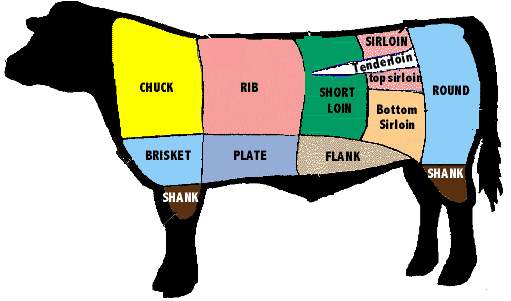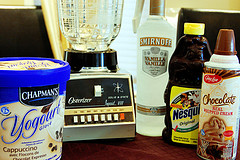There are a LOT of different cuts of beef. Sides of beef are massive and get broken down into many different steaks and cuts.
For a lot of people just thinking about a visit to the meat counter can bring on an onset of anxiety. I can't tell you how often people call me asking if they can use this cut of beef for that recipe or that cut for this recipe. Hopefully I can clarify some of the confusion at the meat counter for you.
To make sure I've got all of my facts straight I stopped in to talk with the fine folks at Uppercut Meat Packers in the St. Lawrence Market in Toronto. They've been cutting down beef and selling it to consumers in this busy market for over 30 years. To understand why some cuts of beef turn out tough or chewy when you try and cook them you need to understand that the beef we eat is muscle. The more the muscle is used, the stronger it is and thus the tougher the beef. Take for example the highly sought after tenderloin. This cut comes from just under the ribs of the cattle. It's virtually unused by the cattle and thus is extremely soft. This butter-soft cut of beef is unfortunately not very large and thus tends to be the most expensive.
To break down tougher cuts of beef there are effectively three methods to ensure they turn out soft and tender. Often a combination is needed to help before, during and after cooking:
 Marinating — allowing raw beef to sit in a marinade that contains an acid helps break down the fibers of the beef. The acid can be any vinegar, citrus juice or the like. You'll find acid as a critical ingredient of any marinade recipe. Often the beef will sit in a marinade for 24 hours to help soften it.
Marinating — allowing raw beef to sit in a marinade that contains an acid helps break down the fibers of the beef. The acid can be any vinegar, citrus juice or the like. You'll find acid as a critical ingredient of any marinade recipe. Often the beef will sit in a marinade for 24 hours to help soften it.
 Slow cooking in liquid
Slow cooking in liquid — by cooking a tough cut of beef slowly over a long period of time the cuts of beef breaks down and begins to soften up. For many larger roasts this is a critical method to ensure tenderness. By cooking in a liquid with a heavy lid the pressure and heat help to ensure your diners aren't chewing away on their main dishes.
 Slicing — tougher cuts of beef should always be cut against the grain. By slicing this way the fibers of the beef are shorter which makes them easier to chew.
Slicing — tougher cuts of beef should always be cut against the grain. By slicing this way the fibers of the beef are shorter which makes them easier to chew.
When heading to the store to shop for beef it's important to have in mind the type of meal you hope to make and the amount of time you have. In general it's easiest to remember the areas of the cattle when buying beef to determine how to cook it.
The high centre cuts: such as the sirloin and rib steak. These are ideal quick-cook steaks perfect for the grill or roasting. The cuts are tender and have great marbling to ensure juicy, well-flavoured meat. These tend to be premium steaks or roasts from the mid-section of the cattle and they are always going to be tender as long as you don't over-cook them! They aren't cheap but you're getting what you pay for. They can be cut into large servings and still be mouthwateringly juicy and tender. Look for: prime rib, rib, rib-eye, strip loin, tenderloin and top sirloin.
Some of the lower center cuts can be tough due to the makeup of the connective tissue. These include braising ribs, flank steak and skirt steak. In general these need marinating and slow cooking in liquid to soften them.
Any hind roast can be oven-roasted such as the eye of round, rump roast, sirloin tip. Oven roasts are cut from the rear hip and tend to be leaner and cheaper than premium roasts. Perfect to roast in the oven they’re great for a weeknight family dinner and do well carved thinly and served with delicious sides and gravy. Look for: rye of round, inside round, outside round, and sirloin tip.
From the front of the cattle the muscles are used for movement and to hold up the cattle's massive head. The front area includes chuck, brisket, and the shank. These cuts are extremely tough and cannot be softened by marinating alone. They must be slow cooked to break them down. In addition these cuts tend to be fattier than those in the mid-section of the cattle. These pot roasts need to be slow cooked for long periods of time such as in a braising in a liquid, stew, or slow-cooker. Look for cross rib, blade, brisket or shank.
Hopefully this helps sort out some of the confusion you find when shopping for different cuts of beef.
Check out this never-fail recipe for making premium or oven roasts at home.
Special thanks to my friends at Uppercut Meat Packers and BeefInfo.org for all of the help!


 Marinating — allowing raw beef to sit in a marinade that contains an acid helps break down the fibers of the beef. The acid can be any vinegar, citrus juice or the like. You'll find acid as a critical ingredient of any marinade recipe. Often the beef will sit in a marinade for 24 hours to help soften it.
Marinating — allowing raw beef to sit in a marinade that contains an acid helps break down the fibers of the beef. The acid can be any vinegar, citrus juice or the like. You'll find acid as a critical ingredient of any marinade recipe. Often the beef will sit in a marinade for 24 hours to help soften it. Slow cooking in liquid — by cooking a tough cut of beef slowly over a long period of time the cuts of beef breaks down and begins to soften up. For many larger roasts this is a critical method to ensure tenderness. By cooking in a liquid with a heavy lid the pressure and heat help to ensure your diners aren't chewing away on their main dishes.
Slow cooking in liquid — by cooking a tough cut of beef slowly over a long period of time the cuts of beef breaks down and begins to soften up. For many larger roasts this is a critical method to ensure tenderness. By cooking in a liquid with a heavy lid the pressure and heat help to ensure your diners aren't chewing away on their main dishes. Slicing — tougher cuts of beef should always be cut against the grain. By slicing this way the fibers of the beef are shorter which makes them easier to chew.
Slicing — tougher cuts of beef should always be cut against the grain. By slicing this way the fibers of the beef are shorter which makes them easier to chew. 







